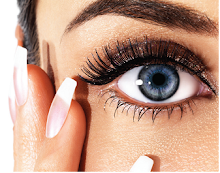Depending upon the nature of the material used in
their manufacturing, the contact lenses can be divided
into following three types:
1. Hard lenses,
2. Rigid gas permeable lenses, and
3. Soft lenses.
1. Hard lenses are manufactured from PMMA
(polymethylmethacrylate). The PMMA has a high
optical quality, stability and is light in
weight, nontoxic,
durable and cheap. The hard corneal lenses
have a diameter of 8.5-10 mm. Presently these are not
used commonly.
Disadvantages of PMMA hard contact lenses. (i)
PMMA is practically impermeable to O2 thus
restricting the tolerance. (ii) Being hard, it can cause
corneal abrasions. (iii) Being hydrophobic in nature,
resists wetting but a stable tear film can be formed
over it.
Note : PMMA contact lenses are sparingly used in
clinical practice because of poor patient acceptance.
2. Rigid gas permeable (RGP) lenses are made up of
materials which are permeable to oxygen. Basically
these are also hard, but somehow due to their O2
permeability they have become popular by the name
of semisoft lenses. Gas permeable lenses are
commonly manufactured from copolymer of PMMA
and silicone containing vinyl monomer. Cellulose
acetate butyrate (CAB), a class of thermoplastic
material derived from special grade wood cellulose
has also been used, but is not popular.
their manufacturing, the contact lenses can be divided
into following three types:
1. Hard lenses,
2. Rigid gas permeable lenses, and
3. Soft lenses.
1. Hard lenses are manufactured from PMMA
(polymethylmethacrylate). The PMMA has a high
optical quality, stability and is light in
weight, nontoxic,
durable and cheap. The hard corneal lenses
have a diameter of 8.5-10 mm. Presently these are not
used commonly.
Disadvantages of PMMA hard contact lenses. (i)
PMMA is practically impermeable to O2 thus
restricting the tolerance. (ii) Being hard, it can cause
corneal abrasions. (iii) Being hydrophobic in nature,
resists wetting but a stable tear film can be formed
over it.
Note : PMMA contact lenses are sparingly used in
clinical practice because of poor patient acceptance.
2. Rigid gas permeable (RGP) lenses are made up of
materials which are permeable to oxygen. Basically
these are also hard, but somehow due to their O2
permeability they have become popular by the name
of semisoft lenses. Gas permeable lenses are
commonly manufactured from copolymer of PMMA
and silicone containing vinyl monomer. Cellulose
acetate butyrate (CAB), a class of thermoplastic
material derived from special grade wood cellulose
has also been used, but is not popular.
3. Soft lenses are made up of HEMA (hydroxymethymethacrylate).
These are made about 1-2 mm larger
than the corneal diameter. Advantages: Being soft
and oxygen permeable, they are most comfortable and
so well tolerated. Disadvantages include problem of
wettability, proteinaceous deposits, getting cracked,
limited life, inferior optical quality, more chances of
corneal infections and cannot correct astigmatism of
more than 2 dioptres.
Note: In clinical practice soft lenses are most
frequently prescribed.
frequently prescribed.




I like this page
ReplyDeletethank you wait for more
DeleteYou have three variety of lenses. In the first lenses, nobody wants to wear at the time of sleeping. The second one is less expensive. The soft lenses are good but here, the demerits of this lenses is that it will be easily broken. We may get more chances of corneal infections through this lenses.
ReplyDeleteI like the hard lenses for this page.
ReplyDeleteYou have three variety of lenses but, i like the hard contact lenses.
ReplyDeleteI like PMMA Contact lense because of the poor patients acceptance.
ReplyDeletethx for commenting hope u liked my blog
ReplyDelete